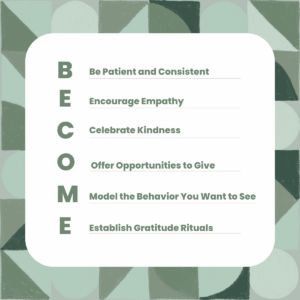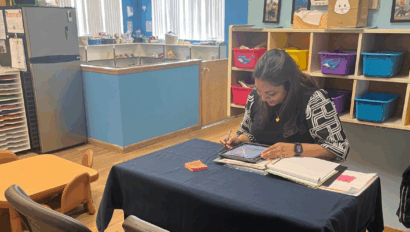Raising Compassionate Kids the Montessori Way in Minnesota

Quick Answer: A Montessori approach nurtures compassion by giving children independence, meaningful responsibilities, and daily opportunities to practice gratitude, empathy, and generosity. With the right guidance, these values become a natural part of who they are.
Why Compassion Belongs at the Heart of Montessori
Montessori learning grows not only through lessons, but through relationships, responsibilities, and respect. We are helping children grow into respectful, empathetic, and capable people. Compassion develops when children are trusted with responsibility, when they feel valued for their contributions, and when they see kindness modeled around them.
Alongside math and reading, Montessori children are trusted with meaningful tasks like helping a classmate, caring for plants, or saying thank you; that nurture empathy and gratitude.
How Montessori Principles Support Gratitude and Generosity
Montessori environments are designed for independence, but that independence always comes with responsibility. A few ways this looks in daily life:
- Practical life activities: Caring for plants, preparing snacks, or setting the table helps children practice giving and contributing.
- Mixed-age classrooms: Older children naturally help younger ones, while younger ones learn from those examples.
- Respectful modeling: Adults thank children sincerely, listen attentively, and guide gently, showing children that kindness and patience matter.
By focusing on the whole child—socially, emotionally, and academically—Montessori creates space for compassion to grow naturally.
The BECOME Framework: A Montessori Lens on Raising Compassionate Kids

Here’s how the BECOME framework connects with Montessori practice:
- B – Be patient and consistent: Just like we don’t rush a child learning to pour water, we give them time to practice gratitude and sharing.
- E – Encourage empathy: In Montessori, children are asked to notice how their actions affect others—whether a classmate waiting for a turn or a friend who feels left out.
- C – Celebrate kindness: We name it when we see it: “You helped your friend tie their shoe. That was thoughtful.” Recognition reinforces the behavior.
- O – Offer opportunities to give: From donating toys to making cards for neighbors, children discover the joy of generosity.
- M – Model the behavior: Children learn by watching. When we thank them sincerely or treat others with respect, they internalize it.
- E – Establish gratitude rituals: Simple routines—like sharing something you’re thankful for at snack or circle time—make gratitude part of the day.
Everyday Montessori Practices Parents Can Try at Home
Here are small ways families can carry Montessori-inspired compassion into daily routines:
- Invite your child to help prepare and serve meals at the table.
- Encourage thank-you notes or drawings for family, teachers, or neighbors.
- Create a family gratitude jar where everyone adds notes about what they appreciate.
- Give your child simple choices—what fruit to cut, what flower to water—so they practice independence with care.
- Make time for quiet reflection or nature walks, giving space for empathy and awareness.
Books, Stories & Resources to Support Parents
Stories and resources give families extra tools to nurture gratitude and compassion at home. Books about kindness or gratitude can spark rich conversations with children. After reading, you might ask:
- “What do you think that character felt?”
- “What would you have done in that situation?”
These moments connect the story to real life and help children practice empathy in ways that stick.
For parents looking for more structured guidance, resources like The Montessori Child: A Parent’s Guide to Raising Capable Children with Creative Minds and Compassionate Hearts offer step-by-step advice on creating Montessori-inspired environments, supporting social and moral development, and weaving gratitude into daily routines.
FAQs Parents Often Ask
Can young children really understand gratitude?
Yes. Even toddlers show empathy when given the chance. Montessori helps guide that natural capacity with real experiences—helping, sharing, noticing.
Do I need Montessori materials at home to do this?
Not at all. The most important tools are your modeling and everyday routines: meals, chores, family rituals.
What if my child doesn’t want to share or be kind?
That’s normal. In Montessori, we see kindness as something children practice over time, just like reading or writing. Gentle consistency and modeling help it take root.
How do schools reinforce this?
Montessori classrooms build community through shared responsibilities, mixed-age learning, and respect for each individual. Compassion is woven into the daily rhythm, not added as a separate subject.
What about resources and stories?
Books and guides can be a huge help. Stories give children examples of gratitude and kindness, while resources like The Montessori Child give parents practical ways to bring those values into daily life.
Final Thought: Compassion Is Part of Growing the Whole Child
Montessori reminds us that educating the whole child means nurturing their heart as much as their mind. Gratitude, kindness, and generosity grow through small daily moments—pouring water for a friend, helping clean up, or saying thank you with sincerity.
Curious to see how this comes to life? Schedule a tour at Minnesota Montessori in Minnesota and explore how Montessori nurtures independence, empathy, and lifelong compassion.


